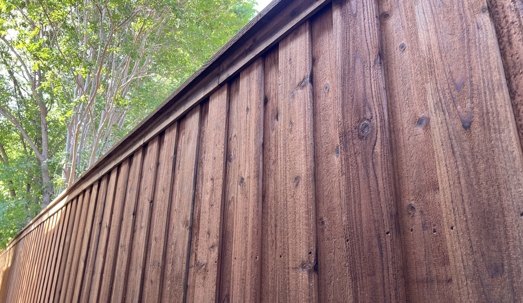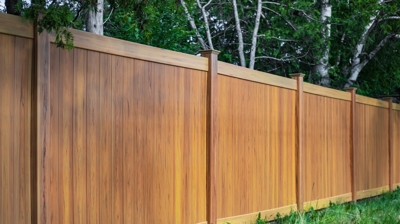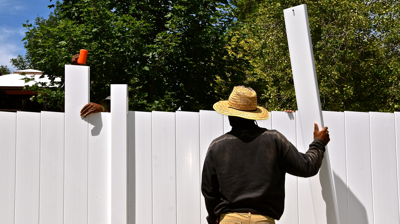Your Complete Guide to Wood Fences
- Table Of Contents
- What Makes Wood So Good for Fencing
- Common Types of Wood Fencing
- Most Common Wood Types Used for Fencing
- Why You Should Go Pro For Installing that New Wood Fence
- What Influences the Cost of a Wood Fencing Project?
- Installation Considerations for Wood Fencing
- Ideas for Adding Value and Appeal to your Wooden Fence
- Final Checklist for Choosing Your Wood Fence
- Stand Strong Fencing Can Help With Any Quality Wooden Fence
Wood fences are a classic and timeless choice for homeowners looking to add a touch of elegance to their outdoor spaces. However, with different types of wood, fence styles, design options, durability, and maintenance requirements, it can be difficult to know which option is best for your needs.
If you're looking to enhance the beauty and privacy of your property with a wood fence but are unsure of where to start, we've compiled this comprehensive wood fence guide to help you navigate through the decision-making process. Choosing the right wood fence for your property involves considering factors that might not even be on your radar yet.
Take a look at our guide for wood fences and ensure you select the perfect wood fence that not only meets your style preferences but also serves the needs of your property.
What Makes Wood So Good for Fencing
To start, consider the benefits of wooden fences when exploring different fence material options, in case you're still not sure wood is the way to go.
Wooden fences can elevate the style of your outdoor space by providing:
- Natural aesthetics that enhance the warmth and beauty of your property.
- Customization options to suit any style or taste.
- Environmentally friendly material that is biodegradable and sourced sustainably.
- Cost-effectiveness, as wood is typically more affordable upfront compared to other common materials.
If you have any concerns about the advantages of wood fencing or its suitability for your property, feel free to contact us for a free quote.
Common Types of Wood Fencing
Wood is a standout choice for fencing materials, offering a range of styles and durability, as previously noted. Wooden fences bring a timeless charm, providing both a level of privacy and enhancing the curb appeal of outdoor spaces.
However, the question remains: which style should I choose? With a variety to select from, the decision should be based on your specific property needs and preferences.
Outlined below are some of the standard wooden fence types, each with its unique advantages and considerations. Therefore, selecting a type that aligns with your requirements and budget is crucial.
Wooden Privacy Fences
Privacy fences are among the most popular types of fences, being the optimal choice for creating comfortable and safe areas in your back or front yards. At the same time, these types of fences have several subtypes, designs, and styles:
- Horizontal fence: One of the more modern and popular privacy fence ideas is horizontal fences, made out of slats that are, well, horizontal. Horizontal privacy fences are the ideal choice for those looking for a modern-looking contrast with vertical elements in your yard or any outdoor space, such as elements like plants, trees, umbrellas, and more.
- Board-on-board: a design where wooden fence boards slightly overlap on either side of the supporting rail and offer complete privacy and a sturdy structure.
- Board-and-Stringer fences: These feature vertical boards attached to horizontal stringers, allowing for airflow and visibility while maintaining a balance between openness and privacy.
- Stockade style: tall wooden fences with tightly spaced pickets for maximum security, commonly seen in farms and commercial settings. Although they are completely meant to be functional, not aesthetic, many property owners enhance their look with murals, plants, vines, and other add-ons.
- Shadowbox fence: uses alternating panels to create a visually appealing design that offers privacy and openness, similar to stockade fences but with a lighter and more visible aesthetic.
Benefits of Wood Privacy Fences
Creates a Private Sanctuary: Privacy fences provide a sense of belonging and a secure environment for gatherings, ensuring a good level of privacy from prying eyes.
Reduces Noise Pollution: They also help minimize noise from the neighborhood, promoting a peaceful and tranquil atmosphere for relaxation.
Weather Protection: Solid panels of privacy fences offer protection from harsh weather conditions, ensuring the longevity of the property.
Enhances Aesthetics: Privacy fences add curb appeal and a new aesthetic element to outdoor spaces, combining security and seclusion for homeowners.
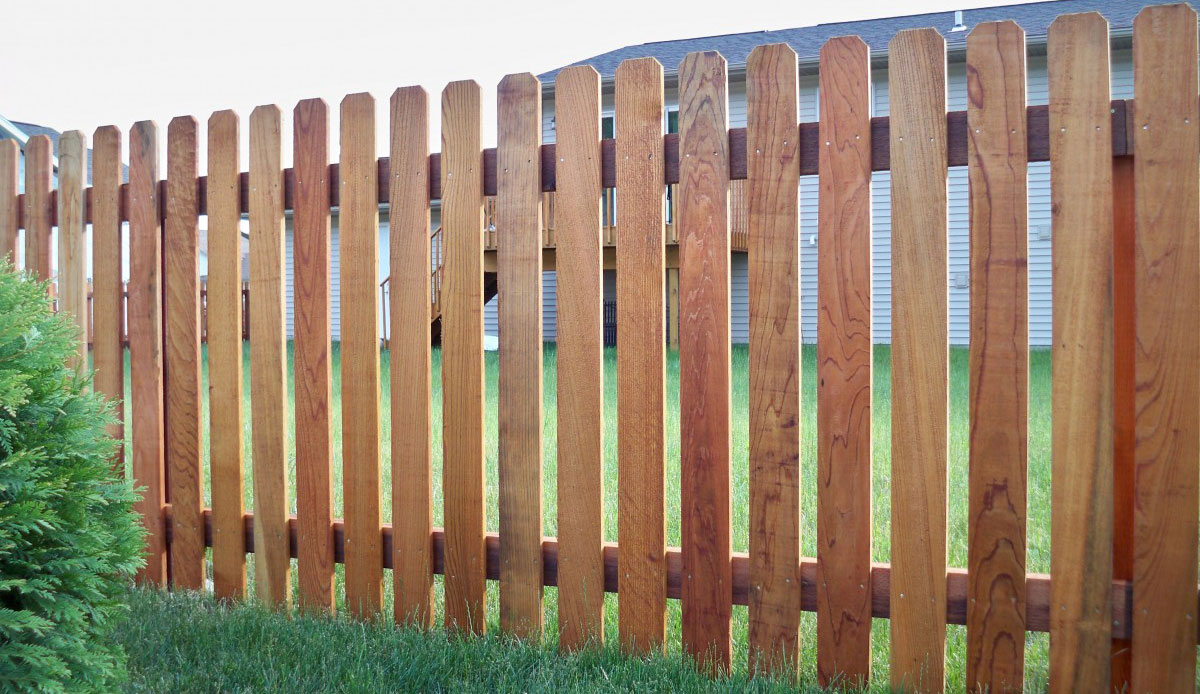
Traditional Picket Fences
Traditional wooden picket fences are timeless and charming additions to any home or property. Constructed from wood, they consist of evenly spaced vertical boards supported by horizontal rails. The classic white picket fence look adds to the overall curb appeal of a property, making it a popular choice for enhancing the aesthetic appeal of a home.
Nonetheless, even this traditional wood fence option has more to offer nowadays. Most fence companies will gladly provide you with different colors, wood types, and styles of fence pickets (the top of the fencing boards that give the style its name.)
Overall, picket fences offer:
- Aesthetic appeal: Adds charm and character to a property, enhancing its overall appearance.
- Boundary definition: They clearly define property boundaries, providing a sense of security and privacy.
- Safety: They can help keep children and pets safely enclosed within the yard, preventing them from wandering off without enclosing the space too much.
- Versatility: Picket fences come in a variety of styles, materials, and heights, making it easy to find one that suits your specific needs and preferences.
- Low maintenance: Depending on the material used, they can be relatively low maintenance, requiring only occasional cleaning or painting.
- Increased property value: Well-maintained, they enhance the curb appeal of a property, potentially increasing its resale value.
- Marking garden areas: Create smaller enclosed garden areas, protecting plants from animals and adding a decorative element to the landscape.
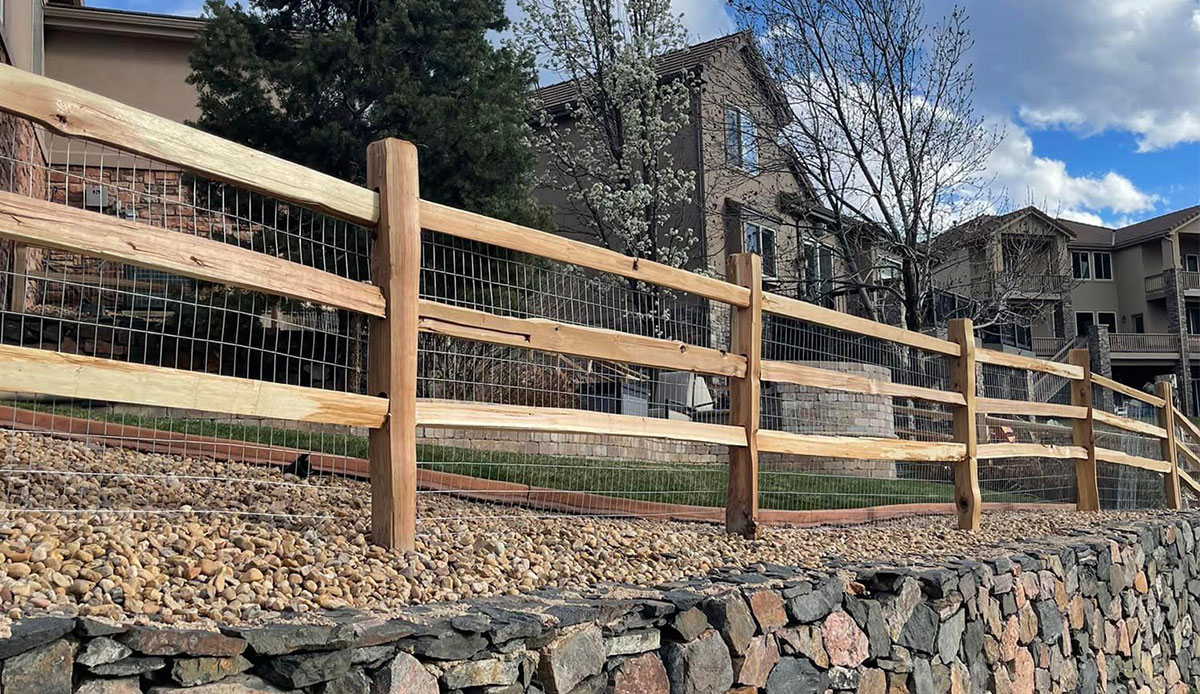
Split Rail Fence
These are a delightful and traditional type of fence made up of wooden rails that have been split lengthwise and placed horizontally amidst wooden posts. This uncomplicated yet appealing fence option is favored for its charm and practical advantages, in addition to being a cost-effective choice. In residential areas, a split rail fence can introduce a touch of rural elegance, outline property limits without obstructing views, and provide a safe environment for pets and children.
For commercial spaces, a split rail can elevate the overall look of the property, establish a warm and inviting ambiance for customers or clients, and offer good visibility while deterring trespassing or vandalism due to its open design. In essence, a split rail fence strikes a perfect balance between functionality and visual appeal for both residential and commercial properties.
Basketweave Fence
This type of horizontal wood fence features a distinctive basketweave design consisting of vertical and horizontal slats intricately woven together to form a robust and attractive barrier.
Renowned for its ability to enhance privacy and security, this style is favored by homeowners seeking to establish a secluded outdoor area. Its sturdy construction ensures longevity and minimal maintenance throughout the years. Not only does the fence provide practical benefits, but its aesthetic appeal can also elevate the overall look of a property, adding a touch of sophistication and allure to the curb. It's considered a more sustainable and aesthetic alternative to chain link fences.
Most Common Wood Types Used for Fencing
As we know, "wood" is a broad term and not actually a single material. There are many types of wood, from cedar to wood-composite, and many options in between. The type for your wooden fencing project will depend on several factors, from building codes to aesthetic preferences, but it's good to first know what each material is best for.
Here are just some of the most common types of wood used in fencing.
Cedar
Cedar is a durable and long-lasting wood that is naturally resistant to decay, rot, and insect damage, making it an ideal choice for outdoor structures that want to emphasize beauty. Its natural oils act as a barrier against moisture, helping to prevent warping and cracking over time. Additionally, cedar has a beautiful and distinct grain pattern, providing an attractive aesthetic for your fence. Plus, a cedar fence is a sustainable and eco-friendly option, as it is a renewable resource that requires minimal energy for processing.
Pine
Pine is an affordable and readily available option, making it a cost-effective choice for those on a budget while still being a high-quality material. It is also a lightweight wood, making it easier to handle and install compared to heavier hardwoods. Pine is naturally resistant to decay and insects, allowing for a longer lifespan for your fence with proper regular maintenance. Additionally, pine is a versatile wood that can be easily stained or painted to match your desired aesthetic.
Redwood
Redwood is known for its natural beauty, rich, warm color, and fine grain that provide an elegant and timeless look to any outdoor space. In addition to its aesthetic appeal, redwood is highly durable and naturally resistant to decay, insects, and rot, making it an excellent choice for a long-lasting fence that requires minimal maintenance. Redwood is also lightweight and easy to work with, allowing for customization and intricate designs. Furthermore, redwood is a sustainable choice, as it is a renewable resource that is harvested responsibly, making it an environmentally friendly option for your fencing needs.
Spruce Fence
Spruce is a popular and affordable softwood option that is readily available, making it a cost-effective choice for fencing projects. Despite being lightweight, spruce is known for its durability and resistance to rot and decay when properly treated and maintained. It is easy to work with, allowing for customization and intricate designs if desired. Spruce also has a natural, light color that can easily be stained or painted to match any aesthetic preference, making it a versatile choice for enhancing the curb appeal of your property.
Bamboo fences
Enhance your property with a tropical flair by incorporating bamboo. While bamboo is known for being cost-effective, long-lasting, and sturdy, its growth and availability may be limited in certain regions. Additionally, without proper maintenance, bamboo can be vulnerable to rot and insect infestation.
Pressure-Treated Wood
One of the key advantages of pressure-treated wood is its resistance to rot, decay, and insect damage, making it a durable and long-lasting attractive option for outdoor structures. This type of wood is also able to withstand harsh weather conditions, such as rain and snow, without deteriorating quickly. Additionally, pressure-treated lumber requires minimal maintenance, saving time and money in the long run. Its affordability and availability in various sizes and styles make it a versatile choice for different fencing designs.
Composite Wood Fence
Composite wood fences are becoming increasingly popular due to their low maintenance requirements and long-lasting durability. These fences are crafted from a combination of wood fibers and plastic, offering the aesthetic appeal of wood without the need for extensive upkeep. Unlike metal fences, composite wood fences do not rust, making them a practical and attractive option for homeowners seeking both style and convenience in their fencing choices.
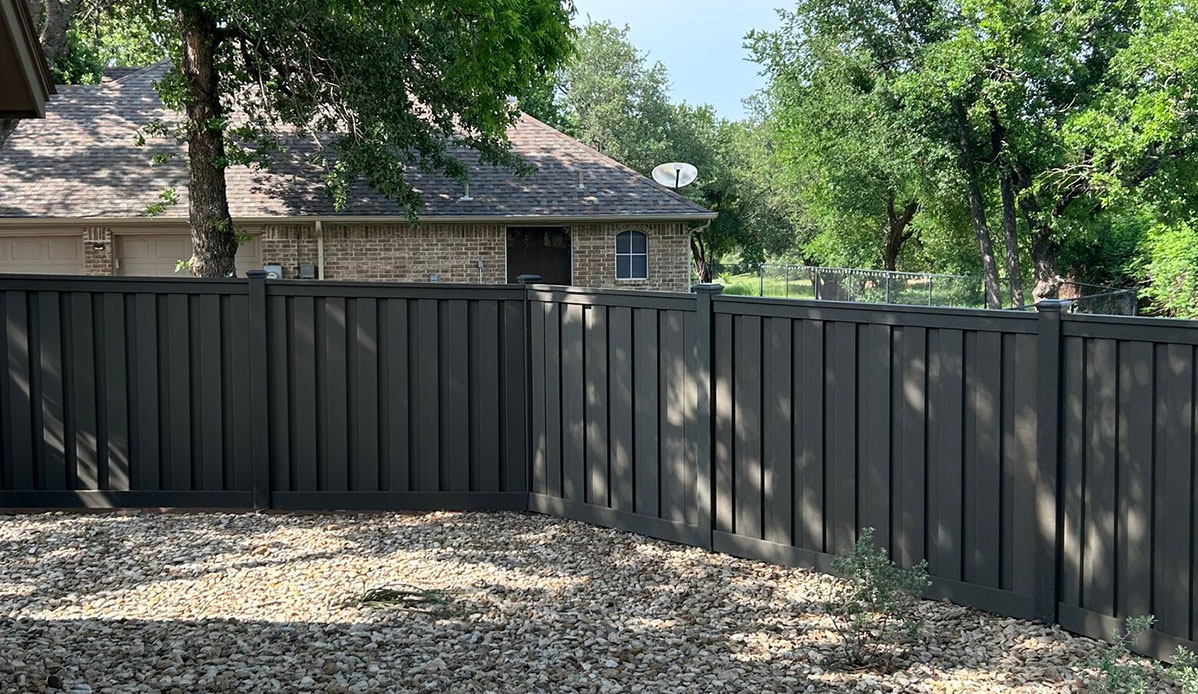
Why You Should Go Pro For Installing that New Wood Fence
When it comes to installing a wooden fence, opting for a professional installation service over a DIY project offers various benefits that can contribute to the overall quality and longevity of the fence:
1. Expertise and Experience:
Professional installers have the knowledge and expertise to properly assess the site, plan the installation process, and address any potential challenges that may arise during the project. Their experience allows them to anticipate issues and ensure that the fence is installed correctly the first time.
2. Quality of Workmanship:
Professional installers have the necessary skills and essential tools to ensure that the fence is installed securely, evenly, and in a way that enhances the overall aesthetic appeal of the property. This attention to detail can result in a fence that not only looks great but also functions effectively.
3. Time and Efficiency:
Installing a fence can be a time-consuming task, especially for individuals with limited experience or tools. Professional installers work efficiently and can complete the project in a timely manner, saving you the hassle of spending weekends or evenings working on the installation. This allows you to enjoy your new fence sooner without sacrificing quality.
4. Compliance with Regulations:
Professionals are familiar with local building codes and regulations governing fence installations. They can ensure that the fence is installed in compliance with these requirements, preventing potential issues with permits or inspections down the line. This can save you time and money in the long run.
5. Warranty and Guarantee:
Many professional installation services offer warranties or guarantees on their work. This provides you with peace of mind, knowing that if any issues arise with the fence after installation, the installer will come back to address them. This level of support and assurance is not typically available with a DIY project.
While DIY projects can be rewarding, opting for a professional installation service for your wooden fence can provide numerous advantages in terms of quality, efficiency, compliance, and peace of mind. By investing in professional installation, you can enjoy a well-built and long-lasting fence that enhances the beauty and functionality of your property.
What Influences the Cost of a Wood Fencing Project?
Besides the type of fence, the cost is probably the most important factor that will make you decide on what your wooden fence will look like.
When considering the cost of a wood fence, it's essential to understand the various factors at play. From the type of wood you choose to the dimensions of the fence, each element can impact the final price.
Wood Material Quality
When considering the cost of your wood fence project, the quality of the wood material significantly impacts the overall expense involved. Opting for higher-quality wood might initially seem pricier, but it can save you money in the long run. High-quality wood is more durable, requiring less frequent fence repairs and replacements, ultimately reducing maintenance costs. Moreover, superior wood materials enhance the aesthetic appeal of your fence, providing a sense of pride and ownership.
Choosing premium wood instills a feeling of belonging as it elevates the look of your property, making it stand out in the neighborhood. Your fence becomes a symbol of your commitment to quality and attention to detail. Additionally, high-grade wood increases the value of your home, contributing to a sense of community and shared prosperity among neighbors.
On the other hand, maybe you need a functional but not perfect or expensive option for that stockade fence or simple picket fence that will divide parts of your property while not being used for security and privacy.
Fence Height and Length
When deciding on the height of your fence, consider your needs for privacy and security. Taller fences require more materials for construction, leading to higher costs. Longer fences, on the other hand, require more materials and labor for installation, which can also increase the total expenses.
Additionally, taller and longer fences may need stronger posts and additional support structures, further adding to the overall cost. Keep in mind that taller and longer fences not only provide more privacy and security but can also enhance the aesthetics of your property.
Before making a decision, carefully assess your requirements and budget constraints. You may find a balance between the height and length of your fence that meets your needs without breaking the bank. Remember, the size of your wood fence plays a significant role in determining the final cost of your project.
Installation Complexity
Installing a wood fence can vary in complexity, impacting the overall cost of the project. Factors such as the terrain of your property, the presence of obstacles like trees or rocks, and the need for special tools or techniques can all contribute to the level of difficulty in fence installation.
If your land is uneven or sloped, it may require more labor and materials to ensure a proper and sturdy installation. Likewise, if there are obstructions that need to be worked around, such as large roots or boulders, this can increase the time and effort needed to complete the project.
Additionally, if your design requires intricate details or special features, this can also add to the complexity of the installation process.
Style and Design Choices
Consider how your chosen style and design preferences will impact the overall cost of your wood fence project. The style of your fence, whether it's a classic picket fence, a sturdy stockade fence, or an intricate lattice design, will play a significant role in determining the final cost. More intricate designs requiring skilled craftsmanship may incur higher labor costs.
Additionally, as we already mentioned, the type of wood you choose, such as cedar or redwood, for a more upscale look will affect the overall price.
Certain design elements, like decorative post caps, intricate gates, or custom patterns, can add to the aesthetic appeal of your fence but also come with added costs. Keep in mind that the size and layout of your yard will also influence the total cost, as larger fences or irregular shapes may require more materials and labor to install.
Location and Accessibility
Got for a strategic placement for your wood fence to minimize potential accessibility challenges. The location of your fence can significantly impact the overall cost of the project. If your property is situated in a hard-to-reach area or has limited access for construction equipment, it can result in higher labor costs.
Consider positioning your fence in a way that allows for easy access for the installation team, reducing the time and effort required to complete the project.
Additionally, the accessibility of your property can affect the transportation of materials. If your location is remote or challenging to navigate, delivery of wood panels and posts may incur additional fees. Choosing a location that's easily accessible can help streamline the fence construction process and keep costs within your budget.
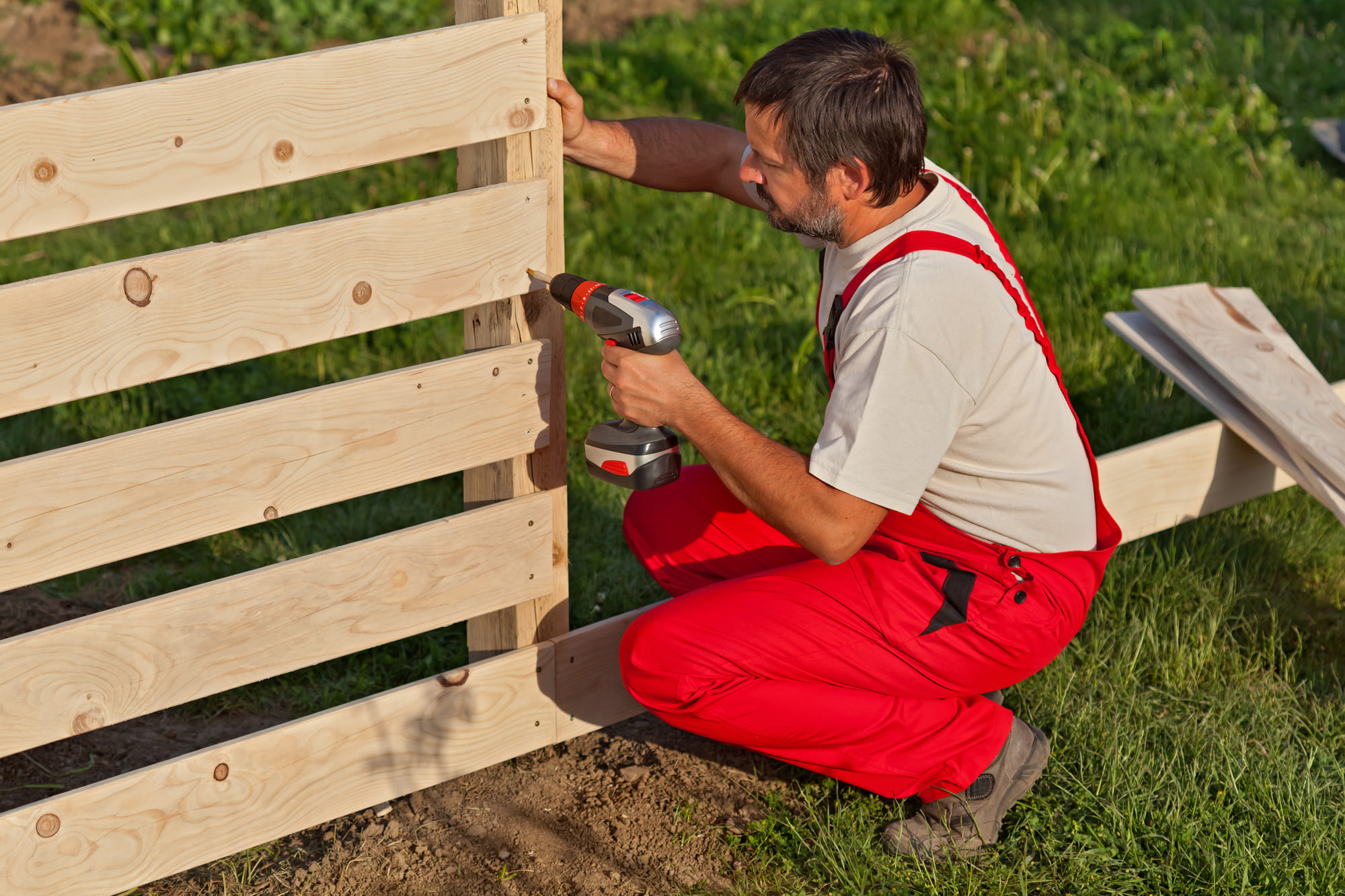
Installation Considerations for Wood Fencing
There is a checklist to follow before starting any fence installation project. This is something that your installers and you, the homeowner, must go through together.
Keeping these things in mind will make your fence building project go more smoothly and successfully.
- Verify property lines through a land survey or deed from the local county office to prevent legal disputes with property owners or encroachments.
- Building permits: Even if there's no HOA in the neighborhood, you still need to check with your local government if there are any building permits you will need to get before altering your property. This will be especially true if you're building tall, private fences that might require you to dig deep post holes or if the linear feet involved in the fence perimeter are of a certain length. This is why DIY installation for any fencing project is not recommended, as professional installers will right away know everything you need in terms of local permits, regulations, and even experience with difficult neighbors.
- Notify neighbors about your plans to install a fence to address any concerns they may have regarding property boundaries or obstructions having to do with the fence height, wildlife, or even aesthetic considerations in cases of privacy fences, which might be too disruptive for a neighbor's backyard.
- Check for underground utility lines by contacting utility companies or using the national 811 call-before-you-dig number to avoid damaging sewage pipes, drains, or internet cables during installation.
Ideas for Adding Value and Appeal to your Wooden Fence
After selecting a wooden fence style, type of wood, and how you'll install it, the work is not over. There are numerous ways to elevate your fence, both before and after it's put up.
If you have an existing wooden fence and wish to revamp it or inject some visual charm into your backyard's old picket fence, consider these creative ideas to make your fence stand out beyond just the type of wood and design.
- Fence Stain or Paint: Transform your fence with a fresh coat of paint or stain for a vibrant and inviting atmosphere while also offering protection from the elements.
- Decorative Tops or Caps: Add decorative tops or caps to customize your fence's look and set your property apart with various designs.
- Change Slat Directions: Experiment with different slat directions to create a modern and sleek design or a unique pattern, instantly revamping the fence's appearance. This could take on many forms, but most apply this idea when using horizontal boards for most of the property, as well as vertical boards for fence gates, for example.
- Plant Bushes or Low Garden: Soften the fence with lush bushes or a low garden to create a more inviting and natural look, blending nature with the fence.
- Metal Posts or Accents: Integrate metal elements for a striking visual contrast, adding a modern touch and durability to the fence. This is especially important before installation when you can ask for metal fence posts to be used instead of just more wood fence posts.
- String Lights or Solar Lanterns: Illuminate the fence with string lights or solar lanterns to create a cozy ambiance and practical lighting for the outdoor area.
- Hang Artwork: Transform your fence into an outdoor gallery by hanging weather-resistant artwork that showcases your personality and artistic flair.
- Prevent Wood Rot: Seal the fence with a waterproof sealant to protect against moisture and regularly inspect for damage to maintain the fence's integrity.
Final Checklist for Choosing Your Wood Fence
Before you're done deciding, here's a final and helpful checklist of every idea, factor, or rule you have to take in mind before finally picking a wood fence:
- Purpose: Consider the main purpose of the fence, such as providing privacy security, defining boundaries, or enhancing the aesthetics of your property.
- Durability: Choose a wood species that is known for its durability and resistance to rot, decay, and insect damage, such as cedar, redwood, or tropical hardwoods.
- Maintenance: Consider the level of maintenance required for the type of wood you choose. Some woods may require regular staining, sealing, or painting to maintain their appearance and longevity.
- Cost: Compare the cost of different wood species and fence styles to ensure they fit within your budget. Keep in mind that higher-quality woods may have a higher upfront cost but could save money in the long run due to their durability.
- Style: Select a fence style that complements the architectural style of your home and enhances the overall look of your property. Popular styles include picket fences, privacy fences, and shadowbox fences.
- Installation: Consider the fence installation process and whether you will be installing the fence yourself or hiring a professional. Some wood fence styles may be easier to install than others.
- Climate: Take into account the climate in your area when choosing a wood species. Certain woods may be more suitable for humid or rainy climates, while others may be better for dry or arid regions.
- Local regulations: Check with your local zoning laws and homeowners' association guidelines to ensure that the type of fence you choose complies with any restrictions or requirements in your area.
- Warranty: Look for wood suppliers or contractors that offer warranties on their products and fence installation services to protect your investment in case of any issues down the line.
- Environmental impact: If you want, consider the sustainability of the wood species you choose and opt for certified sustainable sources if possible to minimize the environmental impact of your fence installation.
Stand Strong Fencing Can Help With Any Quality Wooden Fence
That concludes our wood fence guide. We hope you found it informative but before you go, we want to quickly tell you about our wood fencing services.
With Stand Strong Fencing at your disposal, creating a high-quality wooden fence to enhance your outdoor area is easily achievable. Picture a harmonious fusion of style and robustness that enhances the visual appeal of your property. Stand Strong Fencing presents an array of cutting-edge designs and skilled craftsmanship to help you realize the ideal wooden fence for your outdoor sanctuary.
Whether your preference leans towards a traditional picket fence for a quaint charm or a contemporary horizontal slat design for a polished appearance, Stand Strong Fencing possesses the proficiency to materialize your concept. Our unwavering dedication to excellence guarantees that your wooden fence not only enriches the allure of your outdoor space but also endures the elements for years to come.


